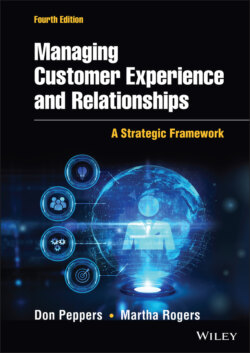Читать книгу Managing Customer Experience and Relationships - Don Peppers - Страница 29
Customers Have Changed, Too
ОглавлениеThe technological revolution has spawned another revolution, one led by the customers themselves, who now demand products just the way they want them and flawless customer service. Enterprises are realizing that if they really know little or nothing about their individual customers, they must capture a clearer understanding of each customer's needs. Customers, meanwhile, want to be treated less like numbers and more like the individuals they are, with distinct requirements and preferences. They are actively communicating these demands back to the enterprise (and, through social media and mobile apps, with each other!). Where they once would bargain with a business, they now tell managers of brand retail chains what they are prepared to pay and specify how they want products designed, styled, assembled, delivered, and maintained. When it comes to ordering, consumers want to be treated with respect. The capability of an enterprise to remember customers and their logistical information such as contact information, shipping address, and ordering preferences not only makes ordering easier for customers but also lets them know that they are important. Computer applications that enable options such as one-click, or express, ordering on the web are creating the expectation that good online providers take the time to get to know customers as individuals so they can provide this higher level of service.7
And again: Treat different customers differently.
The customer revolution is part of the reason enterprises are committing themselves to keep and grow their most valuable customers. Today's consumers and businesses have become more sophisticated about shopping for their needs across multiple channels, and more and more CMOs refer to this as multi-channel marketing or omnichannel marketing. What it really means is that customers will come at companies in various ways, in ways that suit those customers, and companies must be ready to present a logical, coherent response to each customer—not just messages sent through media channels—and to remember what is learned through each interaction and apply that learning to all channels. The idea is not just to make sure that we prepare and send a message, but to make sure each customer receives one. The online channel, in particular, enables shoppers to locate the goods and services they desire quickly and at a price they are willing to pay, which forces enterprises to compete on value propositions other than lowest price.
Contrary to the prevailing belief, a company is not omnichannel just because it is capable of interacting with customers in every possible channel. If the word omnichannel is to mean anything at all, it must stand for a customer experience that is seamlessly integrated across all the different channels any particular customer chooses.
This means a company can only be considered to have omnichannel capabilities if the history and context of each customer's interactions in one channel are flawlessly carried over into the next channel, and the next, and the next. Just because a company can interact with a customer online as well as by phone, and perhaps even by text and chat and social media, it doesn't mean they are an omnichannel company, or that they offer integrated marketing. A company may interact with its customers via a number of different channels, but if these interactions aren't linked together from channel to channel by each customer's own context and history, then the customer will be frustrated and experience more friction than is necessary.
A company may have the capability to handle many channels, but that doesn't mean it has an omnichannel capability. We'll talk more about this in Chapter 8.
A company may have the capability to handle many channels, but that doesn't mean it has an omnichannel capability.
